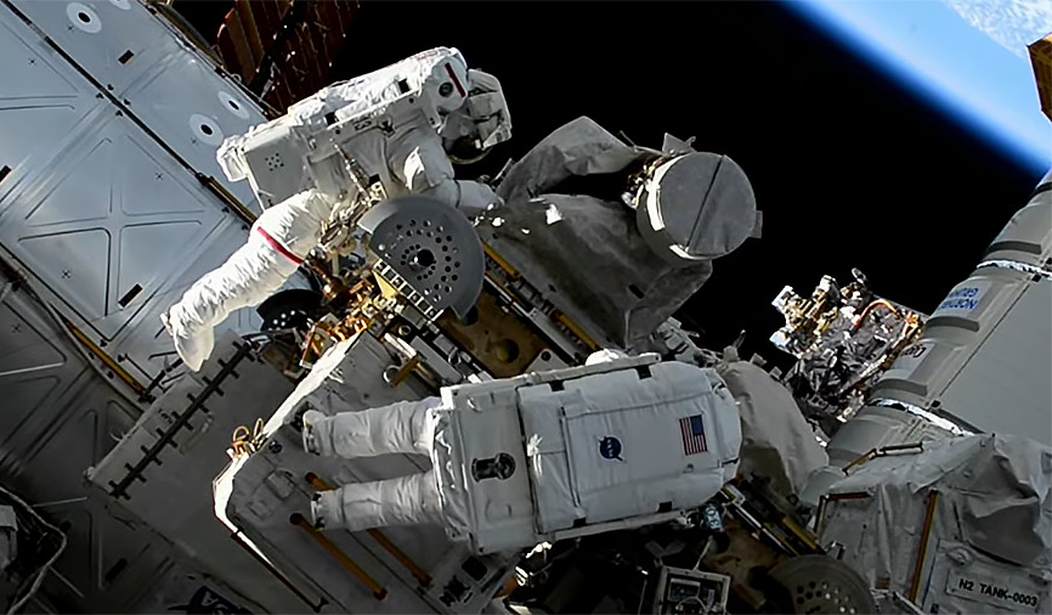This is a first: a prototype of a new series of articles on Sunday covering interesting things that have happened in science or related to science in the preceding week.
And yes, I know it's Monday. Turned out yesterday was a really big news day.
NASA, Thermodynamics, and Kids
NASA is a bother. I have followed NASA since the Mercury program, and I have really liked many things it has done, but after Apollo, it lost its singular focus on putting humans on the moon. Once Nixon cut off the Apollo program, NASA and its political proponents scrambled to find something to keep the band together. This ended up including a lot of meteorology and geography and what we've come to call "climate science." (Remember, if it has to have science in the name, it's not one.)
One part of that was the coming ice age/global warming/climate change theory or collection of theories. I've been covering that in PJ since the original Climategate scandal. One of the things about that has been the... flexibility of their critical faculties. Especially in the public relations world.
Roger Pielke, Jr. pointed out something on ex-Twitter: a post on NASA's Climate Kids page that tells kids that much of the Atlantic and Gulf Coast is going to be underwater when Greenland's glaciers melt, raising sea level by as much as 20 feet.
NASA's Climate Kids page says sea levels are going to rise maybe 20 feet pic.twitter.com/cEyW0i848U
— The Honest Broker (@RogerPielkeJr) January 14, 2024
This caught my attention; it was very familiar. In fact, I ran into basically the same story in December of 2016.
I pointed out a tweet from that time in NASA Nonsense:
If all of Greenland's ice melted, it would raise sea level ~23 ft. That's enough to put coastlines throughout the world under water.
Alla same-same: directed at kids, intended to be frightening, and doesn't stand up to careful scrutiny. There's a long and engrossing discussion, with arithmetic, in my 2016 article, but what it comes down to is that the Greenland ice sheet contains around 3.35 million cubic kilometers, or 3.35 x 10^21 grams of ice. Ice, like every solid, requires extra energy to go from ice to liquid. That's called the enthalpy of fusion, and water turns out to have the second-highest at 344 Joules per gram, beaten only by frozen ammonia. So to melt that much ice, we're talking about 1.1 x 10^24 Joules.
That's a lot of energy. More than 10 million megatons. Twice the Chicxulub asteroid impact that ended the dinosaurs.
In 2016, they were predicting about 4mm of sea level rise per year — not that they actually included their estimate; I took that from the IPCC reports. In this new press release, they have upgraded the estimate to 7 inches a year.
That's certainly more scary — that would account for 20 feet of sea level rise in just about 35 years. The question they never seem to answer is where will the energy come from?
Watch Good Science
I watch a lot of YouTube. If you look, there is actually a lot of good content on science there. I'll be linking one or two of my favorites every week. This week, I want to link Periodic Videos from the University of Nottingham.
I'm weak on chemistry, having done most of my undergrad time as a philosophy major. It's interesting (and if anyone can recommend a decent chemistry text that isn't the new-fangled kind with lots of pictures and white space and historical asides on how women weren't appreciated, I'd be much obliged), and the Periodic Videos show lots of experiments, along with discussion by Professor Sir Martin Poliakoff. You have to stay a little alert because Sir Martin has one of those desiccated British senses of humor — he's funny once you catch on.
There is a particular playlist that I think is good: it goes through every element from hydrogen to the newest, oganesson, element 120. (I'm so old we had nine planets and only 102 elements.) It also has lots of explosions.
Programming Legend Passes: RIP Niklaus Wirth
I started learning to program in 1967 thanks to a pile of "data processing" books I got from various computer companies, and yes, the fact they were "data processing" books tells you just how long ago that was. In 1969, I started programming in RPG/II for money. In 1973, I graduated from high school; in college I studied FORTRAN and RPG/II's big brother COBOL (I wrote about COBOL in the Stack Overflow Blog) and various assemblers.
I wasn't very satisfied with those classes, although I certainly learned a lot, but it was like reading the manual — it concentrated on syntax, but it didn't seem to be teaching how to program.
So I started buying books. Four that I think were important in learning to program were Ed Yourdon's "Techniques of Program Structure and Design," Edsger Dijkstra's "Discipline of Programming" (which I didn't understand until I studied formal logic and more mathematics), and two books by Niklaus Wirth: "Systematic Programming," and "Algorithms + Data Structures = Programs."
Those books, I think, are still among the best books to learn programming, even though they are sadly out of print.
Wirth contributed to ALGOL60, as well as writing one of the first compilers for it. He proposed a dialect of ALGOL called ALGOLW in the standards process of arriving at a new version — it eventually became ALGOL68.
At the same time, he was getting concerned about the same issues of how to teach programming. He created a new language specifically for teaching. That language was called Pascal, and it's one of the most influential programming languages of all time.
Wirth developed many other languages, descendants of Pascal addressing various problems for things that were hard to teach.
The story is that Wirth was asked how to pronounce his name. He answered, "'Niklaus Vir't' f called by name, or 'Nickel's Worth' if called by value."
We know now that was a massive underestimate.










